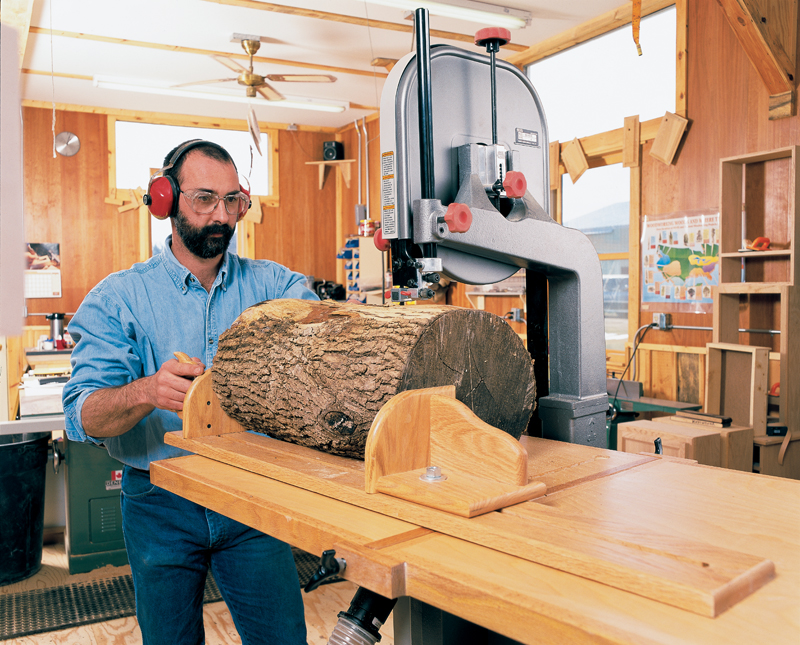Yes, a band saw can be used for resawing lumber. Resawing is the process of cutting thicker pieces of wood into thinner boards and is often done to create a specific shape or size for the final product. The blade on a band saw has the ability to cut in both directions which makes it ideal for this type of application because it allows you to make multiple cuts from one board without having to turn it over or move it around.
Additionally, band saws have adjustable speeds and wide blades that help ensure an accurate cut when resawing lumber.
Yes, a band saw can be used for resawing lumber. It is an ideal tool for cutting thicker boards into thinner ones or for creating veneers and other decorative accents. The blade on the band saw is much wider than the blades of most other types of saws, which allows it to cut through larger pieces with ease.
Additionally, when using a band saw for resawing lumber, you are able to make very precise cuts that would otherwise not be possible with smaller blades.

Credit: www.popularwoodworking.com
How Big of a Bandsaw Do I Need for Resawing?
When it comes to resawing, the size of the bandsaw needed will depend on a few factors such as the thickness and width of your material. Generally speaking, for up to 4” thick pieces you will want at least a 14” bandsaw with a 3/4” wide blade. For thicker materials (up to 8-10 inches) you should use an even larger bandsaw like an 18 or 20 inch model with a wider 1-1/2″ blade.
Keep in mind that if you are working with large and thick pieces, having a heavy duty frame and powerful motor is essential for making clean cuts without too much vibration or strain on your saw.
What is the Difference between a Bandsaw And a Resaw Bandsaw?
A bandsaw and a resaw bandsaw may look similar, but there are some distinct differences between the two. The main difference is in how they are used. A bandsaw is primarily used for cutting curves or making intricate cuts in wood, plastic, metal and other materials.
This type of saw usually has a blade that moves up and down at high speed with teeth on one side so it can accurately cut material into different shapes or sizes. On the other hand, a resaw bandsaw is designed to make straight cuts through thicker materials by moving its blade either horizontally or vertically across the workpiece. It typically features deeper gullets between each individual tooth along its blades to help create cleaner cuts when dealing with larger pieces of material such as logs or boards.
Additionally, unlike a regular bandsaw which often requires more frequent sharpening due to its smaller teeth size, resaws require less maintenance since their deep gullets provide extra support and stability during longer projects involving tougher woods such as hard maple or oak.
What Type of Bandsaw Blade is Best for Resawing?
The best type of bandsaw blade for resawing is a hook-toothed, three-tooth skip pattern. This type of blade has teeth that are shaped like hooks, allowing them to cut through the material more easily and quickly than other types of blades. The skip pattern places one tooth followed by two empty spaces on the same side of the blade.
This helps reduce vibration and increase accuracy when cutting curves or angles in thicker materials. Additionally, a hook-toothed band saw blade is better suited for making long cuts, as it can maintain its sharpness over these extended lengths while providing an even finish on all edges.
Can You Resaw on a Small Bandsaw?
Yes, you can resaw on a small bandsaw. Resawing involves cutting a piece of wood along its length to create two thinner pieces. It is possible to do this with a regular saw blade on many types of bandsaws, however it is important to take certain precautions when working with smaller tools such as using the right type of blade and ensuring that the blade has adequate tension for safe operation.
Additionally, choosing the proper speed setting for your particular material being cut will help ensure an accurate cut and minimize potential kickback from the saw. With these considerations in mind, it is indeed possible to resaw on a small bandsaw safely and accurately.
How to Resaw Lumber — WOOD magazine
What is Resawing on a Bandsaw
Resawing is the process of cutting a thick piece of wood into two or more thinner pieces on a bandsaw. This technique involves adjusting the height of the blade and tensioning it to slice through the material at an angle, resulting in a cleaner cut than other methods such as planing or jointing. Resawing is most commonly used for making veneers, furniture parts, and decorative items from reclaimed lumber.
Resaw Bandsaw for Sale
Are you in the market for a resaw bandsaw? Look no further! We have just what you need.
Our resaw bandsaws are perfect for all your lumber needs, with powerful motors and precision blades that will make quick work of any size project. Whether you’re an experienced woodworker or just getting started, this is the saw for you. Get yours today and start making beautiful projects with ease!
How to Resaw Wood Without a Bandsaw
Resawing wood without a bandsaw is possible with the right tools and techniques. The most common way to resaw by hand is to use a handsaw or coping saw, although other methods such as jigsaws, rasps and files can also be used. When resawing by hand you should take extra care in selecting the right blade for your project, making sure it has plenty of teeth and that they are sharpened regularly.
Additionally, you will need to make sure that your workpiece is firmly secured in place before beginning any cuts. With patience and practice you can easily master this technique!
Best Bandsaw for Resawing
If you’re looking for the best bandsaw for resawing, look no further than the Laguna 14Twelve. This powerhouse of a saw not only offers an impressive 12” throat depth, but also provides easy-to-use controls and adjustable guide systems that make it perfect for achieving accurate cuts. The saw is equipped with a heavy-duty 1 HP motor and features variable speed settings ranging from 90 to 5000 RPMs, so it can handle any type of material you throw at it.
Additionally, its included riser block kit allows you to increase your cutting capacity up to 14”– making this bandsaw ideal for those needing to do serious resawing jobs.
Conclusion
In conclusion, a band saw can be an incredibly useful tool for resawing lumber. It is important to do your research before buying a band saw in order to ensure that it has the features necessary for resawing and the right blade size. Additionally, it is important to understand proper safety precautions when using any power saw, including a band saw, in order to avoid injury while working on projects.
With knowledge of how to use and care for a band saw properly, you will have the ability to make accurate cuts quickly and safely.
Table of Contents

